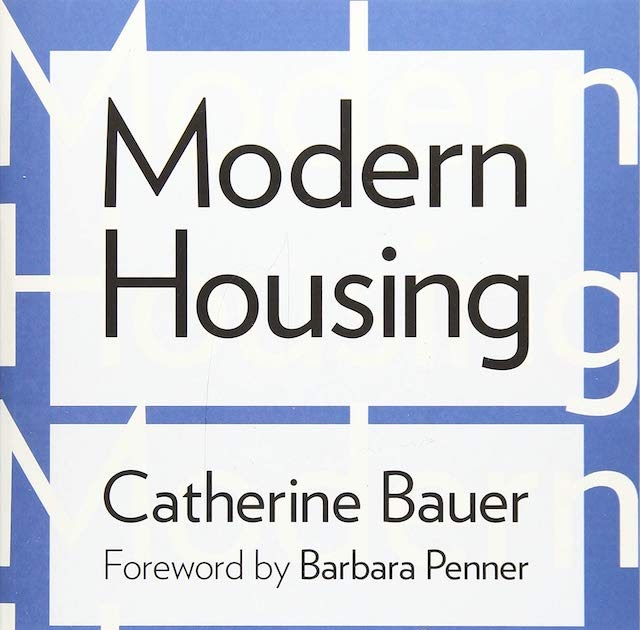Modern Housing
Modern HousingCatherine Bauer; foreword by Barbara PennerUniversity of Minnesota Press, April 2020Paperback | 6 x 9-1/4 inches | 400 pages | 175 illustrations | English | ISBN: 978-1517909062 | $35.00PUBLISHER'S DESCRIPTION: Originally published in 1934, Modern Housing is widely acknowledged as one of the most important books on housing of the twentieth century, introducing the latest developments in European modernist housing to an American audience. It is also a manifesto: America needs to draw on Europe’s example to solve its housing crisis. Only when housing is transformed into a planned, public amenity will it truly be modern. Modern Housing’s sharp message catalyzed an intense period of housing activism in the United States, resulting in the Housing Act of 1937, which Catherine Bauer coauthored. But these reforms never went far enough: so long as housing remained the subject of capitalist speculation, Bauer knew the housing problem would remain. In light of today’s affordable housing emergency, her prescriptions for how to achieve humane and dignified modern housing remain as instructive and urgent as ever. Catherine Bauer (Wurster) (1905–1964) was a leading public housing advocate and a lecturer at the University of California, Berkeley, where she was instrumental in the creation of its College of Environmental Design. Barbara Penner is an architectural historian and professor of architectural humanities at the Bartlett School of Architecture, University College London. REFERRAL LINKS: dDAB COMMENTARY: I hate to admit it, but I wasn't aware of Catherine Bauer's 1934 book, Modern Housing, until October 2018, when Barbara Penner wrote a lengthy introduction to a text by Bauer for Places Journal's Future Archive series. Penner begins her 5,000-word essay about Bauer and her article, "The Dreary Deadlock of Public Housing" from the May 1957 issue of Architectural Forum, by describing Modern Housing as "seminal." Later, she calls the book "a polemic, a rallying cry for [...] planned, government-sponsored, noncommercial housing in America" and "a radical and perfectly timed intervention into contemporary housing debates." But try as I might, finding a copy of Modern Housing was next to impossible, with just 1,500 copies printed in 1934 and plans for an edited reissue to be done by the author with MIT Press waylaid by Bauer's untimely death in 1964 at the age of 59. Even though it comes 86 years after the original, this paperback reprint of Modern Housing, published by the University of Minnesota Press, is very welcome — as is the foreword by Penner, who expanded upon the Places Journal essay for the book. The foreword starts similarly, stating that "Modern Housing should need no introduction. Nor should its author, Catherine Bauer." Although an unfortunate situation, it appears I'm not alone in requiring introductions for both. Modern Housing would be the only major book for Bauer, who wrote just one other, the "short, rousing" A Citizen's Guide to Public Housing in 1940. Penner also describes Bauer's career subsequent to Modern Housing as "complex" and deserving of more space than the foreword allows: heading the United States Housing Authority's Division of Research and Information; lecturing on public housing at UC Berkeley (she met her husband, William Wurster, there); vice president of the California Housing and Planning Association; vice president of the National Public Housing Conference; cofounding the National Committee on Housing Emergency. The impressive list goes on, but needless to say housing and community planning were central to Bauer's professional life. Modern Housing was published two years after Modern Architecture: International Exhibition was held at the Museum of Modern Art (MoMA) in New York. Most people know it as The International Style, the name of the book — not the eponymous catalog (link to 34mb PDF) — by Henry-Russell Hitchcock and Philip Johnson that came out of the exhibition they curated. Notably, at least in the context of this review, the book removed the section on housing, which was done by Lewis Mumford, a mentor of Bauer's. The omission of housing, outside of a few housing projects documented in photos and drawings in the book, indicates a preference for form and style over social concerns. This is very much in opposition to Bauer, who did not separate the idea of modern architecture from that of modern housing and was a strong advocate for public housing, both in the book and in her later career(s). With an affordable housing crisis persistent in and beyond the United States, a reprint of Bauer's book now is as timely as it is welcome, particularly given increasing calls for governments to step up again and create public housing, instead of depending on the market and giving developers incentives for supplying so-called "affordable" units. The particulars of Modern Housing may be long out of date, but the ideas behind them offer lessons for contem

Catherine Bauer; foreword by Barbara Penner
University of Minnesota Press, April 2020
Paperback | 6 x 9-1/4 inches | 400 pages | 175 illustrations | English | ISBN: 978-1517909062 | $35.00
PUBLISHER'S DESCRIPTION:
REFERRAL LINKS:
SPREADS:









